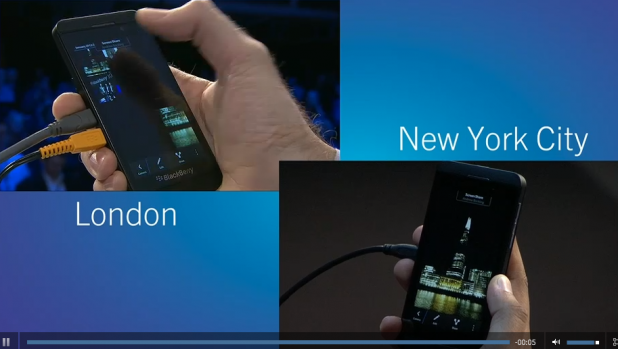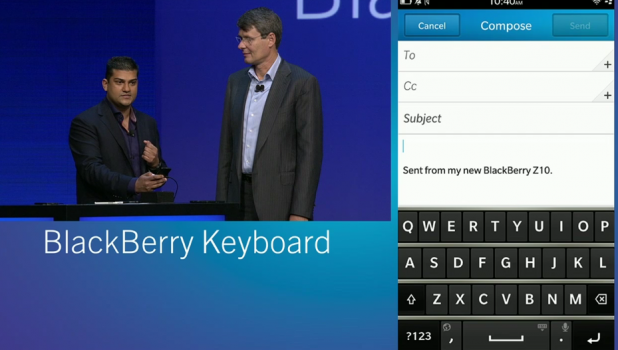 On the consumer side of the equation, BlackBerry 10 features a robust picture editor, complete with filters and effects (“Enhance,” “Artistic,” etc.). There’s Story Maker, which lets the user select pictures and videos stored on the device, pair them with some music, slap a few titles and credits across the presentation, and then sit back as BlackBerry 10 creates a slideshow. BlackBerry 10 will launch on two devices, one with a full-length touch screen and the other with a physical QWERTY keyboard. If the nifty smartphones fail on the open market, RIM has precious few options left. Heins suggested to the German newspaper Die Welt earlier in January that the company could sell off its hardware production arm, or else license its software to various manufacturers. Lenovo CFO Wong Wai Ming also told an interviewer at the World Economic Forum’s annual meeting in Davos, Switzerland, that his company could make a play for RIM, although Lenovo later made a point of downplaying those comments. Image: RIM
On the consumer side of the equation, BlackBerry 10 features a robust picture editor, complete with filters and effects (“Enhance,” “Artistic,” etc.). There’s Story Maker, which lets the user select pictures and videos stored on the device, pair them with some music, slap a few titles and credits across the presentation, and then sit back as BlackBerry 10 creates a slideshow. BlackBerry 10 will launch on two devices, one with a full-length touch screen and the other with a physical QWERTY keyboard. If the nifty smartphones fail on the open market, RIM has precious few options left. Heins suggested to the German newspaper Die Welt earlier in January that the company could sell off its hardware production arm, or else license its software to various manufacturers. Lenovo CFO Wong Wai Ming also told an interviewer at the World Economic Forum’s annual meeting in Davos, Switzerland, that his company could make a play for RIM, although Lenovo later made a point of downplaying those comments. Image: RIM RIM Unveils BlackBerry 10, Its Big Turnaround Hope
Research In Motion has whipped the curtain back from BlackBerry 10. The revamped operating system is widely perceived as RIM’s best chance at staying relevant in a smartphone market dominated by Google Android and Apple’s iOS. Once a significant player in mobility, RIM watched its earnings and market-share crumble over the past few years. Government agencies and large enterprises, once the most reliable RIM customers, have begun abandoning BlackBerry devices in favor of other hardware, including employees’ personal devices configured to run on an office network. Combine that with fierce competition from Android and iOS, and it was clear that RIM needed to do something radical. That “something radical” includes abandoning the longtime BlackBerry user interface, centered on grids of icons, in favor of one built on the same QNX technology that powers RIM’s PlayBook tablet. The BlackBerry 10 home-screen offers “live tiles” that dynamically refresh with updated information, and RIM is playing up how users can move between apps and alerts by swiping and flicking the screen. Just in case gesture control wasn’t enough to persuade iPhone and Android device owners to switch over to BlackBerry 10, RIM is throwing in some other features, which executives demonstrated at a high-profile event in New York City. For starters, there’s a revamped keyboard with the ability to “flick” whole words into the message, allowing those on the run to compose with a single finger. (For those working in multilingual industries, the keyboard supports multiple languages.) Onstage, RIM CEO Thorsten Heins emphasized BlackBerry 10’s privacy and security features. “We see people running around with two devices, a personal one and a corporate one,” he said. “This is a problem.” RIM’s solution is BlackBerry Balance, which allows BlackBerry 10 users to move between separate personal and work environments on the same device with a few swipes. The “corporate side” of the phone maintains all the necessary encryption and privacy policies, even as the user continues to run “fun” apps on the personal side. BlackBerry 10 includes an updated version of BlackBerry Messenger. The company’s messaging service now features video calling, which brings it to parity with Apple’s FaceTime and other rival applications. BlackBerry Messenger also allows users to share their smartphone screen with others using the service—a potential boon to those who need to collaborate over projects while on the road:  On the consumer side of the equation, BlackBerry 10 features a robust picture editor, complete with filters and effects (“Enhance,” “Artistic,” etc.). There’s Story Maker, which lets the user select pictures and videos stored on the device, pair them with some music, slap a few titles and credits across the presentation, and then sit back as BlackBerry 10 creates a slideshow. BlackBerry 10 will launch on two devices, one with a full-length touch screen and the other with a physical QWERTY keyboard. If the nifty smartphones fail on the open market, RIM has precious few options left. Heins suggested to the German newspaper Die Welt earlier in January that the company could sell off its hardware production arm, or else license its software to various manufacturers. Lenovo CFO Wong Wai Ming also told an interviewer at the World Economic Forum’s annual meeting in Davos, Switzerland, that his company could make a play for RIM, although Lenovo later made a point of downplaying those comments. Image: RIM
On the consumer side of the equation, BlackBerry 10 features a robust picture editor, complete with filters and effects (“Enhance,” “Artistic,” etc.). There’s Story Maker, which lets the user select pictures and videos stored on the device, pair them with some music, slap a few titles and credits across the presentation, and then sit back as BlackBerry 10 creates a slideshow. BlackBerry 10 will launch on two devices, one with a full-length touch screen and the other with a physical QWERTY keyboard. If the nifty smartphones fail on the open market, RIM has precious few options left. Heins suggested to the German newspaper Die Welt earlier in January that the company could sell off its hardware production arm, or else license its software to various manufacturers. Lenovo CFO Wong Wai Ming also told an interviewer at the World Economic Forum’s annual meeting in Davos, Switzerland, that his company could make a play for RIM, although Lenovo later made a point of downplaying those comments. Image: RIM
 On the consumer side of the equation, BlackBerry 10 features a robust picture editor, complete with filters and effects (“Enhance,” “Artistic,” etc.). There’s Story Maker, which lets the user select pictures and videos stored on the device, pair them with some music, slap a few titles and credits across the presentation, and then sit back as BlackBerry 10 creates a slideshow. BlackBerry 10 will launch on two devices, one with a full-length touch screen and the other with a physical QWERTY keyboard. If the nifty smartphones fail on the open market, RIM has precious few options left. Heins suggested to the German newspaper Die Welt earlier in January that the company could sell off its hardware production arm, or else license its software to various manufacturers. Lenovo CFO Wong Wai Ming also told an interviewer at the World Economic Forum’s annual meeting in Davos, Switzerland, that his company could make a play for RIM, although Lenovo later made a point of downplaying those comments. Image: RIM
On the consumer side of the equation, BlackBerry 10 features a robust picture editor, complete with filters and effects (“Enhance,” “Artistic,” etc.). There’s Story Maker, which lets the user select pictures and videos stored on the device, pair them with some music, slap a few titles and credits across the presentation, and then sit back as BlackBerry 10 creates a slideshow. BlackBerry 10 will launch on two devices, one with a full-length touch screen and the other with a physical QWERTY keyboard. If the nifty smartphones fail on the open market, RIM has precious few options left. Heins suggested to the German newspaper Die Welt earlier in January that the company could sell off its hardware production arm, or else license its software to various manufacturers. Lenovo CFO Wong Wai Ming also told an interviewer at the World Economic Forum’s annual meeting in Davos, Switzerland, that his company could make a play for RIM, although Lenovo later made a point of downplaying those comments. Image: RIM 

